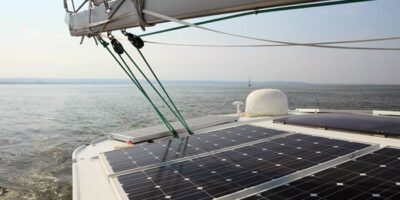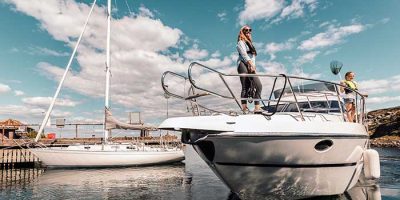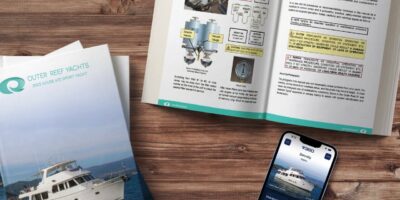Environmentally Friendly Below The Waterline
The evolution of environmentally friendly paints below the waterline. Effective antifouling for low environmental impact.
- January 25, 2024
Over the past five years, below the waterline paint manufacturers have made great strides in creating effective antifoulants that greatly reduce impact on the environment. Selecting a “green” bottom paint no longer means choosing a less effective one. Before we look at the options, let’s take a brief tour of the history of bottom paints on boats.
A papyrus document from the 4th century B.C. references the use of arsenic mixed with sulphur and oil to prevent fouling. In the 14th century, Chinese admiral Cheng Ho ordered the hulls of his junks coated with lime juice mixed with poisonous oil. In 1625, a British inventor patented a paint mixture that included copper and iron powder. Both inhibited marine growth. Since that patent, versions of copper-based paints have dominated the market. Tributyltin, or TBT, entered the scene in the 1950s.
By the 1980s and ’90s, TBT ran into regulatory banishment, because the effects of TBT paint go beyond the organisms that it is intended to kill. By poisoning barnacles, algae, and other organisms at the bottom of the food cycle, TBT works its way up the entire marine food chain. It has been shown to harmfully affect many layers of the ecosystem, including invertebrates and vertebrates—even humans.
Green Future
Bottom paints affect the environment in two ways: organic compounds evaporating into the air and chemicals (mostly copper) leaching into the sea.
If you have been around a freshly painted bottom, you know about the strong odor. The smell is caused by solvent evaporating from the wet paint, allowing it to dry.
These solvents consist of volatile organic compounds, or VOCs, which can be harmful to human beings and to the environment as a whole.
By changing to water-based formulas, chemists and paint manufacturers have reduced VOCs in antifouling paints by roughly 75 percent. In addition to greatly reducing VOCs, these products can be cleaned up with soap and water with out contaminating water around the boatyard. Removing copper presents another challenge. For many years, boat owners selected the heaviest gallon of bottom paint, reasoning correctly that heavier paint meant more copper, sometimes more than 70 percent by volume. While the harmful effects of copper are far less certain than that of TBT, high concentrations found in harbors caused concern.
In 2011, Washington State passed legislation that will gradually eliminate bottom paints containing more than
0.5 percent copper. In the past few years chemists found a way to remove the copper, replacing it with Econea, a metal- free pharmaceutical formulation. Econea is biodegradable, non-corrosive to dissimilar metals, and has even been FDA-approved for dandruff shampoos. Instead of utilizing a makeup of 50 percent cuprous oxide, a solution with only 6 percent Econea affords equivalent level of protection.
Both copper and its equivalent, Econea, maximize their effectiveness on hard growth, such as barnacles. The area along the waterline tends to accumulate slime, or soft growth. Many copper- based bottom paints included a chemical known as Irgarol to deal with slime. In 2015, BASF, the company that produces
Irgarol, surprised the marine industry by announcing that this algaecide would not be available. No date has been set for its reintroduction, as a combination of environmental compliance issues and production decisions have stopped the process. Zinc-based additives have stepped in to provide a similar result.
When it comes to environmentally safe bottom paints, boat owners have three options: low VOCs and no copper (smallest environmental footprint), low VOCs with copper, or higher VOCs (though still EPA compliant), with copper (largest footprint). Prices differ, and some products have advantages over others, depending on use and region. Nonetheless, it is now possible to have a highly effective bottom paint with minimal, negative environmental impact.
Applied Solution
When applying a water-based paint for the first time, pay close attention to the instructions on the can. Check compatibility with the existing coating on
your boat, and pay attention to the type of roller, thickness of coats, and drying times.
A more conventional paint might call for a 3/8-inch nap roller, while the water- based might specify 3/16. When choosing paints, chemical composition matters: More Econea and more zinc translates into better antifouling properties.
No discussion of bottom paints would be complete without exploring one more area of emerging technology. A number of companies now offer antifouling systems based on ultrasound. Transducers attached to the inside of the hull emit low-wattage ultrasonic pulses that resonate through the laminate to the outer surface, producing micro-cavitation bubbles. These bubbles disrupt the cellular structure of marine micro-fouling. These systems do not claim to replace bottom paint; they extend the paint’s life and effectiveness.
A source of power must be available, whether from shorepower or solar panels. Hulls cored below the waterline require special care: The core must be removed for each transducer and the area laminated so that the transducer directly contacts the inner surface of the outer skin.
Most cruising powerboats end the core at the waterline, and in those cases, no additional work is needed. The number of transducers needed depends on vessel size and configuration. A 40-foot trawler would need four to six transducers, depending on the product chosen and hull shape. Running gear protection requires additional transducers.
Environmental protection can be a thorny topic, with unclear answers and complex choices. You will pay more for a gallon of low-VOC, copper-free paint, but you won’t sacrifice effectiveness and you will be keeping the air and water cleaner.
Steve Zimmerman
Zimmerman Marine
About Vessel Vanguard
Vessel Vanguard is a leading marine safety and maintenance management software provider dedicated to revolutionizing the maritime industry. With a commitment to innovation and excellence, Vessel Vanguard delivers cutting-edge solutions to streamline operations and enhance vessel performance and safety.
Latest Industry Insights

Embracing E-Boating Efficiencies

Boat Fuel Systems

The Future of Boats & Boating

Yacht Navigation Light Inspection
View All of Our Industry Insights
Navigate maritime with the latest news, practical how-to guides, insightful analyses and more.
